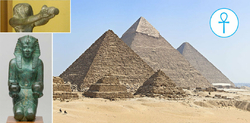- Retour accueil
- Vous êtes ici : Blog The Pyramids of the Cold The Pyramids of the Cold Section 34 • The filtering kidneys of a smart traveler
The Pyramids of the Cold Section 34 • The filtering kidneys of a smart traveler
Publié par Bruno Coursol dans The Pyramids of the Cold le 10/04/2023 à 10:50
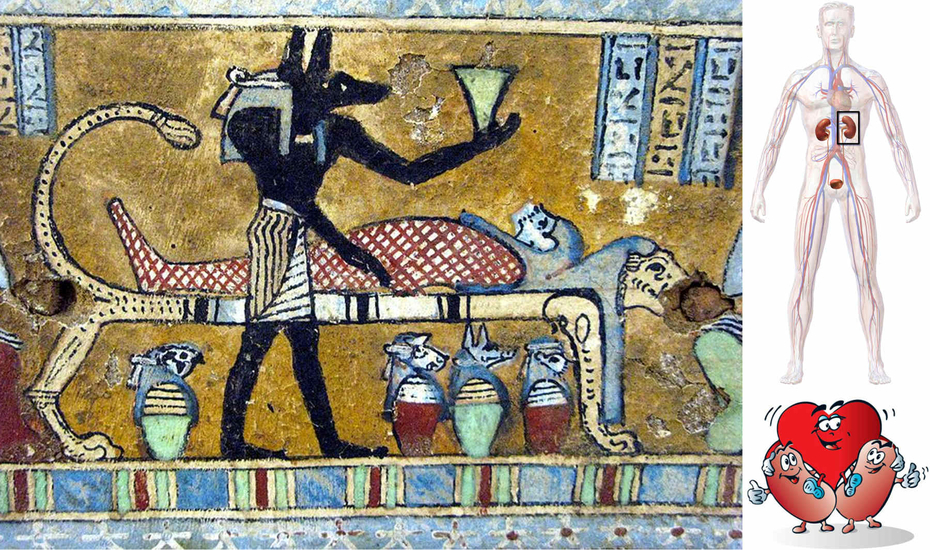
The Pyramids of the Cold Section 34 • The filtering kidneys of a smart traveler
In summary: the mummification process is probably the most noticeable aspect of the ancient Egyptian civilization, but just like everything else, it had been completely misunderstood. After all, egyptologists actually are nothing less but "specialized" historians; and just like you need scientists and low-tech engineers to understand the Great Pyramid, you need biologists and physicians to understand the hidden meaning of the mummification process.
Indeed, everything about ancient Egyptian mummification is referring to physiology, sickness and in particular to seasickness; and the reason for that is because the long process of mummification has been directly associated with the endless cycle of operation of the Great Pyramid.
In other words, the great trip of the deceased towards immortality is mimicking the endless great trip of the impactor of the Pyramid.
• If both the heart and the kidneys of the deceased were (sometimes, or most of the time), left inside the body during mummification, it is because of the codependent relationship which exists between these two organs, and because they both referred to the Great Pyramid's operation and the supply of the inclined well with filtered softened and microbiologically stable water from the biosand filter "sarcophagus": the sarcophagus was literally the kidneys of the Pyramid.
• If all the other organs had been systematically taken out of the body and four of them had to be protected inside what has been incorrectly called "canopic" jars, it is because they had to be protected from the physiological inconveniences which inevitably accompanied the endless operating "trip" of the impactor from the central caisson of the Gallery to the inclined well of the Pyramid.
1 • the lungs needed to be protected from water entering respiratory tracts, that could cause pulmonary aspiration and drowning (the "peeing" baboon-headed Son of Horus Hapy).
2 • the stomach needed to be peaceful and protected from seasickness (the "lifting" figures of Anubis' metaphor and the jackal-headed Son of Horus Duamutef)
3 • the intestines needed to be peaceful and protected from the traveler's diarrhea (the "high-speed dive" of the falcon metaphor and the falcon-headed Son of Horus Qebehsenuef)
4 • the liver needed to be protected against your "best buddy" Son of Horus Imsety with whom you would have bad eating habits while inactive and prevented from exercising in the wooden coffin of the impactor
I'm still surprised to see how profoundly and unconsciously arrogant were the first egyptologists from the 19th century, how bad they felt superior to ancient Egyptians and how much it obscured their judgment towards what this magnificent civilization had really accomplished 4500 years ago. From a 19th century western point of view, ancient Egyptians simply couldn't be associated with anything else than farmers desperately waiting for the Nile to bring new soil every year during the flood, and who also once in a while got to haul and stock stone blocks to build massive pyramids and temples.
The Four Sons of Horus who are represented onto the lids of the canopic jars, are not the protectors of the organs but the exact opposite: they are the dangers which are gonna have to be avoided by the deceased during the long trip of the mummification process.
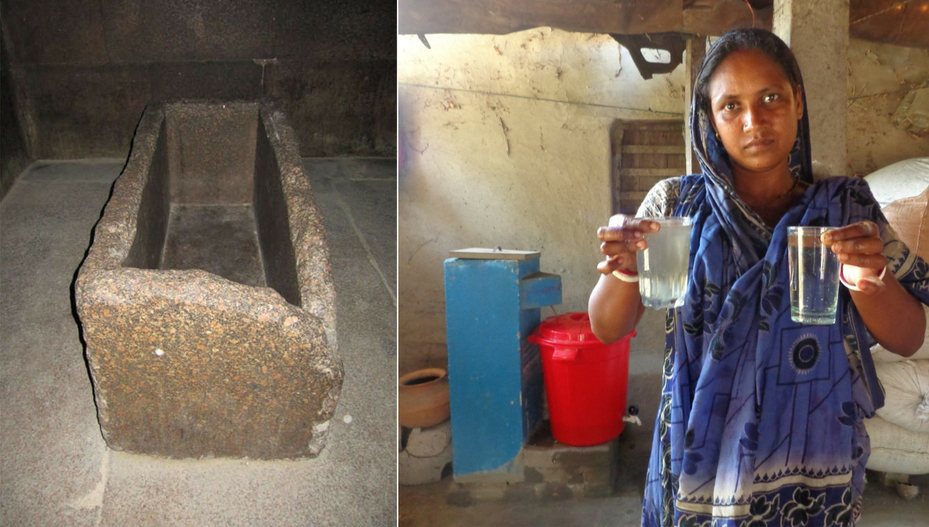
The sarcophagus of the Great Pyramid of Giza was the "mold" of an ancient Egyptian biosand water filter.
"How to make a wooden mold for biosand water filters", by Rob Goodier at https://www.engineeringforchange.org/news/how-to-make-a-wooden-mold-for-biosand-water-filters/
34.01 Kidneys are the filtering organs of the human body
"The kidneys are two bean-shaped organs, each about the size of a fist. They are located just below the rib cage, one on each side of your spine. Healthy kidneys filter about a half cup of blood every minute, removing wastes and extra water to make urine": https://www.niddk.nih.gov/health-information/kidney-disease/kidneys-how-they-work#:~:text=The%20kidneys%20are%20two%20bean,extra%20water%20to%20make%20urine.
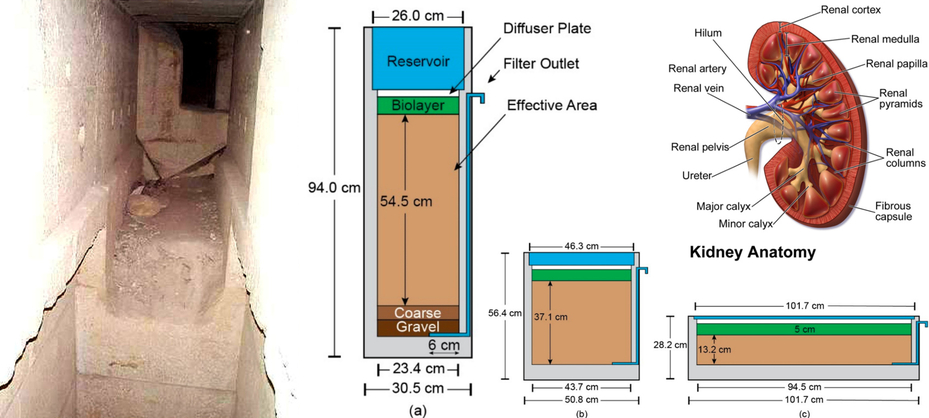
Photograph of the interior of the Bent Pyramid, one of the three great pyramids built by king Sneferu (the founding pharaoh of the Fourth Dynasty of Egypt during the Old Kingdom): https://guardians.net/egypt/cyberjourney/dahshur/bentpyramid/bent_pyramid_interior.htm
34.02 The biosand filter sarcophagus of the Great Pyramid
"Visualizations and volumetric properties of (a) a traditional biosand water filter (BSF) design; (b) a 40% reduced-height design; and (c) a 70% reduced-height design." https://www.mdpi.com/2073-4441/12/5/1337
"Two modeling experiments were conducted using the properties of each filter. The first modeling experiment was to estimate the average flow rate and pressure distribution throughout the traditional and alternate BSF designs. The second modeling experiment was to estimate the percent removal of E. coli and MS2 as a function of depth and grain size for each filter. Four different types of media (coarse, medium–coarse, medium, and fine sand) with varying hydraulic conductivities (K) and grain sizes were chosen for the experiments, as outlined in Table 2. These media were chosen to represent the common types of sand used for filtration systems. Each media type was used for each model, resulting in a total of twelve experimental trials (three designs with four media types) each for fluid modeling and contaminant modeling (twenty-four total)."
"Modeling Improved Performance of Reduced-Height Biosand Water Filter Designs" by James A. Phillips (Department of Chemical Engineering, University of Florida, Gainesville, FL 32611, USA) and Samuel J. Smidt (Soil and Water Sciences Department, University of Florida, Gainesville, FL 32611, USA).
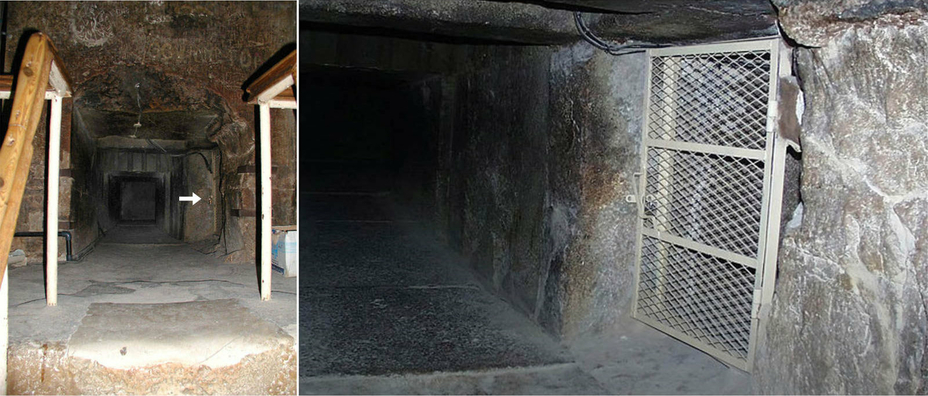
The white arrow is pointing to the little technical room which today is used as an electrical room, but where was set the biosand filter "sarcophagus", 4500 years ago. At least, it remains a technical room: biosand filtration has simply been replaced by electricity, like in many places all around the world.
34.03 The sarcophagus of the Great Pyramid could have produced 201.96 liters of filtered water every 15 minutes
I've suggested the hypothesis that every 15 minutes or so, it was about 200 liters of water that would have been ejected from the inclined well towards the evaporative cooling passage. It just sounded right, but I didn't check one thing: was the biosand filter sarcophagus able to supply that amount of water?
I'm not an engineer, so this whole "practical" thing about numbers is clearly not my cup of tea, even if it was both crucial for the operation of the Great Pyramid and very easy basic science:
With an internal surface area of 1.98 m x 0.68 m = 1.3464 m², and a theoretical flow rate of 600 liters/hour/square meter (according to ACF data, below), the biosand filter of the Great Pyramid of Giza would have been able to supply 807.84 liters of filtered water every hour.
That is 201.96 liters of softened and microbial stable water every 15 minutes.
"The internal dimensions [of Khufu's Sarcophagus] are roughly 198 cm (6.50 ft) by 68 cm (2.23 feet), the external 228 cm (7.48 ft) by 98 cm (3.22 ft), with a height of 105 cm (3.44 ft)." https://en.wikipedia.org/wiki/Great_Pyramid_of_Giza
"The biosand filter has been designed to allow for a filter loading rate (flow rate per square meter of filter area) which has proven to be effective in laboratory and field tests. This filter loading rate has been determined to be not more than 600 liters/hour/square meter." From ACF: https://www.actionagainsthunger.org/sites/default/files/publications/Biosand_and_ceramic_filters_training_manual_02.2010.pdf
"ACF is a Non-Governmental Organisation (NGO). It can also be called Action Contre la Faim (ACF) which is a French phrase meaning Action Against Hunger. ACF began in France in 1979 and currently, it operates in 40 countries worldwide."
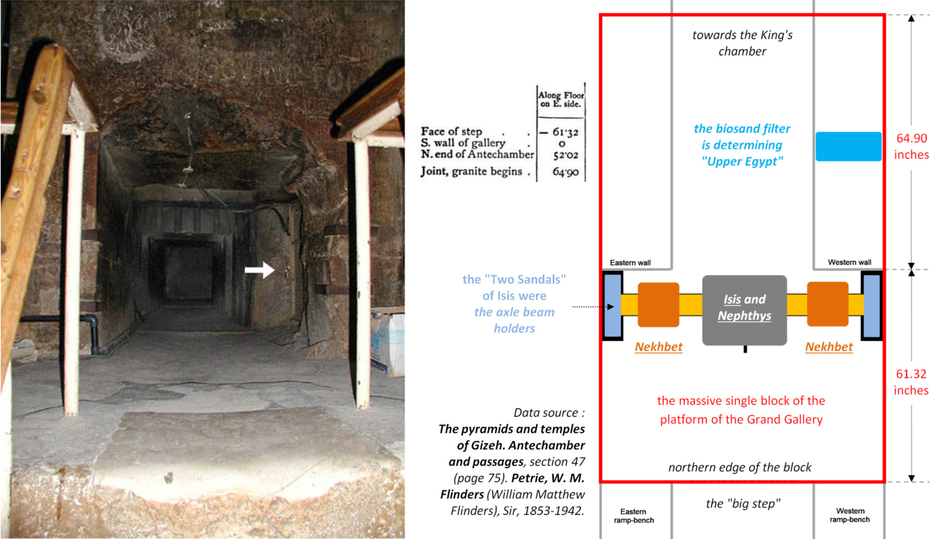
34.04 The Two Lands of Egypt are the "Land of the Filter" and the "Land of the Well"
If the so-called sarcophagus was the biosand filter of the operating Great Pyramid of Giza, which explains why the kidneys of the deceased were left inside the body during the mummification process, its filtered water was produced for the inclined well: both the filter and the well were acting as a single functioning unit, just like the kidneys and the heart in a human body.
In previous Sections, I was able to determine that what is called today "Upper and Lower Egypt", actually referred entirely in a separation made by ancient Egyptians between the Upper and Lower "part" of the Great Pyramid; and I was able to situate the separation between these two "lands" within the huge single block constituting the upper platform of the Grand Gallery.
But because of this new comprehension of the codependent role of the filter and the well, I think we can assume with very high certainty that this Upper part of the Pyramid was actually entirely determined by the biosand filter itself, as it is indeed set onto this upper platform.
In other words, what is known today as "Upper Egypt" is indirectly the glorification of the filter, and of course "Lower Egypt" is referring to the inclined well.
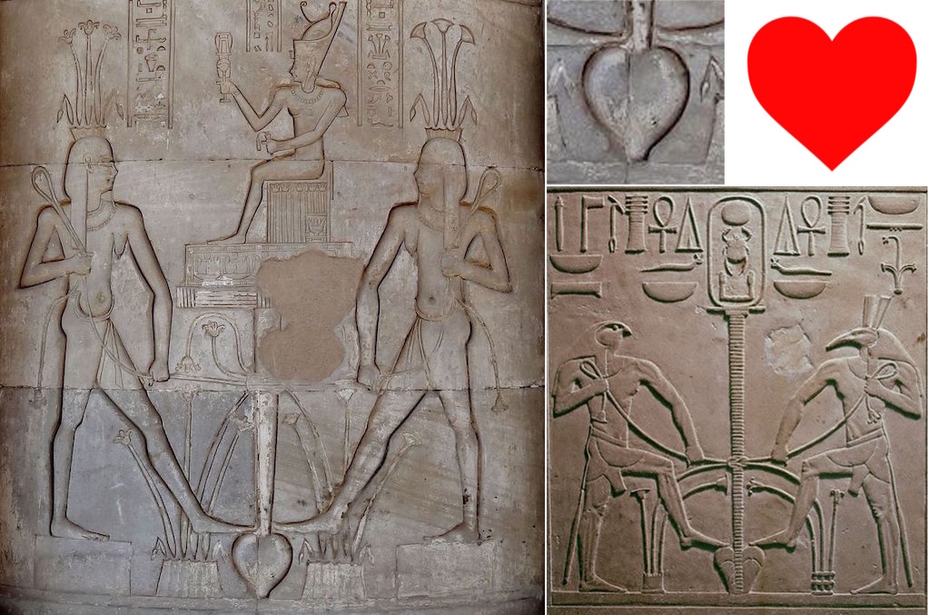
The Sema Tawy thanks to James Vincent: https://twitter.com/jjvincent/status/1587431263551590402/photo/1
"Relief of Horus and Seth. In this decoration showing the theme of the unification of the Two Lands ‘Sema Tawy’, Horus and Seth replaced Hapi, which was associated with the Nile god. Detail on the side of the throne of King Senusret I." at the Egypt Museum: https://egypt-museum.com/relief-of-horus-and-seth/
34.05 The Sema Tawy unification of the Two Lands representations involved Horus and Seth
This interpretation of the Two Lands, as the glorification of the "Land of the Filter" and the "Land of the Well", is also explaining why it is most of the time Horus and Seth who are performing the act of unification of these Two Lands. The Two Lands of the Pyramid were indeed separated by the Grand Gallery: the realm of Horus (the impactor), Seth (the pressurized air created and fought by Horus himself), and Thoth (the sledge runners on which was moving Horus).
"There are many depictions of the ritual unifications of the Two Lands. It is not known if this was perhaps a rite that would have been enacted at the beginning of a reign, or merely a symbolic representation. Many of the depictions of the unification show two gods binding the plants. Often the gods are Horus and Set, or on occasion Horus and Thoth". https://en.wikipedia.org/wiki/Upper_and_Lower_Egypt
34.06 The Origin of the Heart symbol and its association with Love
We've already seen in previous Sections that the Sema Tawy symbol representing the unification of the Two Lands, was the origin of our own modern heart symbol; but now we can analyze it even better.
• the upper horizontal line of the Sema Tawy symbol could refer directly to the massive single block that is the upper platform
• Horus and Seth (representing the realm of the Grand Gallery) are probably indicating with their feet resting onto the heart symbol that not only the heart represented something which was right under their feet, meaning "below the Grand Gallery", but they also indicated that some pressure was applied to it.
Of course, what is below Horus and Seth, what is below the Grand Gallery is the inclined well.
In other words, the symbol which looks like a modern heart in the Sema Tawy representations, is the real origin of our modern heart symbol: it was not blood pressurized inside a human heart, but water pressurized inside the inclined well.
Not only, the inclined well functioned like a living beating heart but what really gave life to it was the endless pounding of the ramming impactor which would have looked like endless sexual intercourse; and this is why our modern heart symbol is also the symbol for love; it is literally about "making love".

"CardioRenal Syndrome: The Relationship of Heart & Kidney Health" thanks to aHUS Alliance. " Cardiorenal syndrome is a fairly recent term to describe the long-recognized group of medical characteristics (syndrome) which coexist between heart (cardio) and kidney function (renal). When either the kidneys or heart are not fulfilling their vital tasks, there can be a harmful and two-way interaction where decline in one of these major organs can seriously undermine function of the other." https://www.ahusallianceaction.org/cardiorenal-syndrome-the-relationship-of-heart-kidney-health/
Heart and kidneys logos: https://portneufmedicalgroup.org/codependent-relationship-between-kidneys-and-heart
34.07 Just like the heart is in a codependent relationship with the kidneys in a human body... the inclined well of the Great Pyramid is also in a codependent relationship with the sarcophagus biosand filter
The problem with egyptology, is that it has been entirely confiscated by historians and architects; when it should have been entrusted to scientists, low-tech engineers, biologists and doctors: if the heart and the kidneys are the only organs left inside the body during mummification, it is because both organs are completely interdependent to each over. The heart and the kidneys are in a codependent relationship.
Because the inclined well was the source of the small amount of pressurized water, maybe about 200 liters every 15 to 20 minutes or so, which transformed itself into a fog of microdroplets to produce evaporative cold, that water had to be treated (More on the sarcophagus in Section 18):
• the water in the well had to be softened to minimize salt deposits
• the water in the well had to go through microbial stabilization to avoid microbial growth
"Fortunately, if you’re doing anything to lower your risk of heart disease, you’re also helping your kidneys remain healthy, too. […] “These organ systems are intertwined, so what’s good for the heart is good for the kidneys and vice versa” says Cleveland Clinic nephrologist and hypertension specialist Michael Lioudis, MD."
Excerpt from an article written in Cleveland Clinic, "The Close Link Between Your Heart Health and Kidney Health, What's good for one is good for the other" available at: https://health.clevelandclinic.org/the-close-link-between-your-heart-health-and-kidney-health/
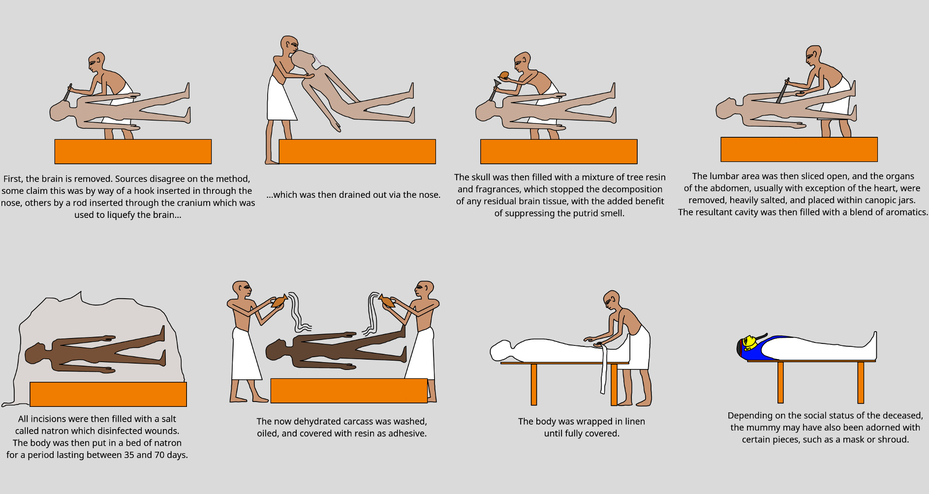
"Simplistic representation of the Ancient Egyptian mummification process", by SimplisticReps: https://en.wikipedia.org/wiki/Mummy#/media/File:Mummification_simple.png
34.08 Heart and Kidneys were the only organs left in the body during the mummification process
It is common knowledge that the heart was systematically left inside the body during the mummification process performed by ancient Egyptians, but it is generally less known that kidneys were also often left in the body, with the heart. This association was not systematical though; and for some reason, the heart was sometimes left alone.
I sincerely am unable to understand why sometimes kidneys were left inside the body and why sometimes, they had been taken out; but what I am certain of is that when they were left inside the body, it certainly wasn't because the embalmers "couldn't get them out" or because they were "unaware" of their presence as it is suggested in so many articles.
To be honest, the vision We, "collectively" see ancient Egyptians is to me eyes, sadly tragic. But when We look at them like they were 4 year-old kids playing in the sand box, it actually is ourselves who are looking like 4 year-old kids playing with a cigarette butt.
Ancient Egyptians invented the 365 days year, the 24 hours day, medicine and we still don't have the slightest idea of how they managed to build their great pyramids and how they had moved their astonishing gigantic statues… and some people are still arguing if they were aware of the presence of the kidneys in the body. Are you kidding me?
In one article, the author is even suggesting that if some kidneys had been left inside the body, it was because they were unable to get them out; even if they obviously didn't have any problem getting the liver out, the biggest internal organ of the human body. Are you kidding me, really?
"The Egyptian “Book of the Dead” (1600-1240 B.C.), which served as a reference work to assist the deceased in the afterlife, is one of the first known texts that mentions the heart and kidneys in parallel: "Homage to thee, O my heart! Homage to you, O my kidneys!". The heart and the kidneys were the only organs left inside the body during the process of mummification. The heart was weighed against the feather of truth by the jackal-headed Anubis (Figure 1), but the exact role of the kidneys for the passage into afterlife is uncertain. Blood vessels are well preserved in mummies, and there is evidence that cardiovascular disease affecting both the heart and the kidneys were not uncommon." Origins of Cardiorenal Syndrome and the Cardiorenal Connection", by L. G. Bongartz, M. J. Cramer and J. A. Joles available at: https://www.researchgate.net/publication/221928884_Origins_of_Cardiorenal_Syndrome_and_the_Cardiorenal_Connection#pf2

"The ancient Egyptians practiced mummification for more than two thousand years, but they have left us no description of the surgical procedures undertaken during embalming. The closest we have are the few papyri that describe what happened to the mummy after the surgical procedures".
"The Rind Papyri, discovered in 1856 by Alexander Rhind, a Scottish Lawyer, describes many details of mummification (Birch 1863). The two Rind Papyri were discovered in an intact tomb of the Roman period. The first was prepared for Montu-Sehef, who lived in Mermothes and died at the age of 59 in 9 BC, during the first year of the reign of Emperor Augustus. Written in both hieratic and demotic, it provides interesting details of mummification. The papyrus specifies the exact dates on which various rituals of mummification take place. We learn that the mummy was bathed in the "Pool of Khonsu," the legs, arms, torso and back were at rest for thirty days in the "Place of Cleansing". The papyrus states that during the first thirty-six days of mummification, eight ceremonies were performed, followed by an additional nine days until the seventh day, when the mummy was finally placed in its tomb. Considering all the ceremonies described in the papyrus, it is surprising that there is no mention of the surgical procedures, the removal of the brain and evisceration, performed at the time of mummification."
"When they have gathered to treat the body after it has been slit open, one of them thrusts his hand through the opening in the corpse into the trunk and extracts everything but the kidneys and heart"
"We know from examination of mummies that Diodorus is correct about the incision being on the left side. The advantage is that there is better access to the descending colon from the left side. When Diodorus mentions that the heart and kidneys were left in situ, he is again correct, though sometimes the kidneys were removed. After Diodorus, the records about the surgical procedures in mummification are silent for two thousand years."
"As we have mentioned, there is no ancient text that details the removal of the internal organs at the time of mummification and there are many unanswered questions about this procedure. For example, we do not know the order in which the organs were removed, nor why sometimes the kidneys were left in place but in some mummies were removed. It is often assumed that because the ancient Egyptians practiced mummification, they were knowledgeable in anatomy, but this is not necessarily true. We must remember that embalmers worked through a small abdominal incision, unable to see the organs as they dissected them. This is literally like performing surgery in the dark. There is no definite word in Middle Egyptian for "kidney". It is possible that some embalmers were unaware that there were kidneys. Also, to anyone with even a rudimentary knowledge of anatomy, it seems strange that there were only four canopic jars; there are more internal organs. It has been pointed out that the hieroglyphic determinative of both internal and external organs are of animals, not humans. This suggests that ancient Egyptian physicians were more familiar with animal anatomy than human anatomy. As far as we know, the ancient Egyptians did not practice dissection until the Ptolemaic times and this certainly supports the theory that the ancient Egyptians were not so skilled in anatomy as their patients would have liked. To answer some of the questions left for us by the ancient embalmers, we attempted to replicate the procedures used."
"Our experimental removal of the internal organs establishes at least a reasonable order in which the organs could have been removed. An observation relevant to the ancient embalmers' knowledge of anatomy is worth noting. Some organs, such as the kidneys hidden behind the peritoneum, could indeed have been unnoticed or easily overlooked by the embalmers."
Excerpts (slightly edited) from "Surgical Procedures during Ancient Egyptian Mummification", presented in March 1999 by Bob Brier* and Ronald S. Wade**; available at: https://www.scielo.cl/scielo.php?script=sci_arttext&pid=S0717-73562001000100021
*Long Island University, Philosophy Department, Greenvale, NY. **University of Maryland, School of Medicine, Baltimore, MD, U.S.A.
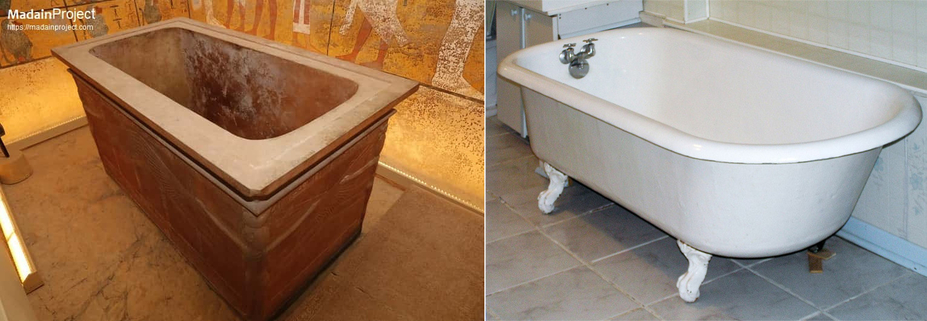
"Quartzite Sarcophagus of Tutankhamun", by the Editors of the Madain Project: https://madainproject.com/quartzite_sarcophagus_of_tutankhamun
"Cast iron bathtub with porcelain interiors on "claw foot" pedestals, 19th century": https://en.wikipedia.org/wiki/Bathtub#/media/File:Clawfoot_bathtub.jpg
34.09 Are you kidding me? Really, no bathtub for natron solution mummification has ever been discovered?
The Queen Hetepheres, the mother of King Khufu, from the fourth Dynasty; her organs were actually preserved in a natron solution. It is also believed that the burial of Queen Meresahkh, also from the fourth Dynasty, her body was left in a natron solution for approximately 200 days as preparation for mummification. The embalming process usually took seventy days. There was some delay between the time of her death and her burial. But to submerge a body into a natron solution, the large container would have to be larger than a bathtub, and these containers have not been found as of yet". http://myweb.usf.edu/~liottan/prepofthemummy.html

Ancient Egyptian representations of the biosand filter of the Great Pyramid (Irynefer drinking potable water directly from the ground, because sand is nothing less than earth), and the inclined well. More on Irynefer and the biosand filter in Section 26.22
Photograph from the tomb of Irynefer, thanks to kairoinfo4u: https://www.flickr.com/photos/manna4u/11433332256/in/photostream/
Detail of an image from the ARCE, American Research Center in Egypt in partnership with the American University in Cairo Egyptology Department. KV 11: Rameses III, Side chamber Cc, rear wall. Valley of the Kings, East Valley, West Bank, Luxor. Image #21076 by Matjaz Kacicnik, taken on December 2005 : https://thebanmappingproject.com/images/21076jpg
34.10 The real meaning of the Heart and Kidneys left inside mummified bodies
Of course, when ancient Egyptians did left both the kidneys and the heart of the deceased, inside the body during the mummification process, it was not to demonstrate that they knew about the filtering function of the kidneys and the fact they also had a codependent relationship with the heart; their real goal was to compare the heart and kidneys of the deceased with the heart (the inclined well which functioned like a living pulsating heart), and the filtration unit of the Great Pyramid (the biosand filter sarcophagus in its original position).
There actually could have been two real meanings for the heart and kidneys to be left in the body, and both would ensure that the mummification process was successful:
• the deceased could have wanted to compare himself to the power and efficiency of the inclined well: "I am worth it! My Heart is as good and as powerful as the Heart of the Great Pyramid"
• or the deceased could have wanted to draw all the necessary energy required for the mummification process, directly from the Great Pyramid itself: "May the Heart of the Great Pyramid give me all its power and efficiency!"
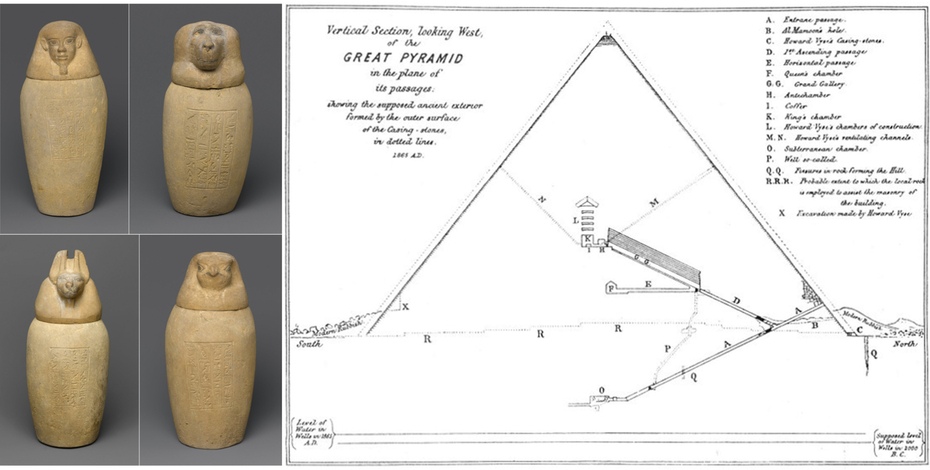
"Canopic jars and lids" at the Brooklyn Museum."Canopic jars first appeared in the tomb of Hetepheres, the mother of Khufu, builder of the Great Pyramid." https://www.brooklynmuseum.org/opencollection/objects/4109
The Grand Gallery's orientation North-South in the Great Pyramid of Giza, : https://commons.wikimedia.org/wiki/File:The_Secret_Teaching_of_All_Ages_-_Chapter_6_-_Pyramid.jpg
34.11 Canopic jars first appeared in the tomb of Khufu's mother… of course because of the Great Pyramid
If the heart and potentially the kidneys were left in the body for mummification, only four of the other organs were saved and stored into four so-called "canopic jars" which were supposed to protect the lungs, the stomach, the intestines and the liver.
It is common knowledge that these jars were intended to hold the separately mummified internal organs of the deceased, but it is rarely mentioned that these jars only first appeared in the tomb of Hetepheres, the mother of pharaoh Khufu, the builder of the Great Pyramid.
What we are gonna discover now explain why it was the Great Pyramid which triggered the wonderful story hiding within the canopic jars.
"Canopic jars first appeared in the tomb of Hetepheres, the mother of Khufu, builder of the Great Pyramid. They were intended to hold the separately mummified internal organs. The middle-class examples of canopic jars, which first appeared seven hundred years later, are often dummies like these, never hollowed out to hold the organs, but still included in the tomb. Canopic jars demonstrate the development of a custom at a royal cemetery that was then adopted in a cheaper form by the middle class." https://www.brooklynmuseum.org/opencollection/objects/4109
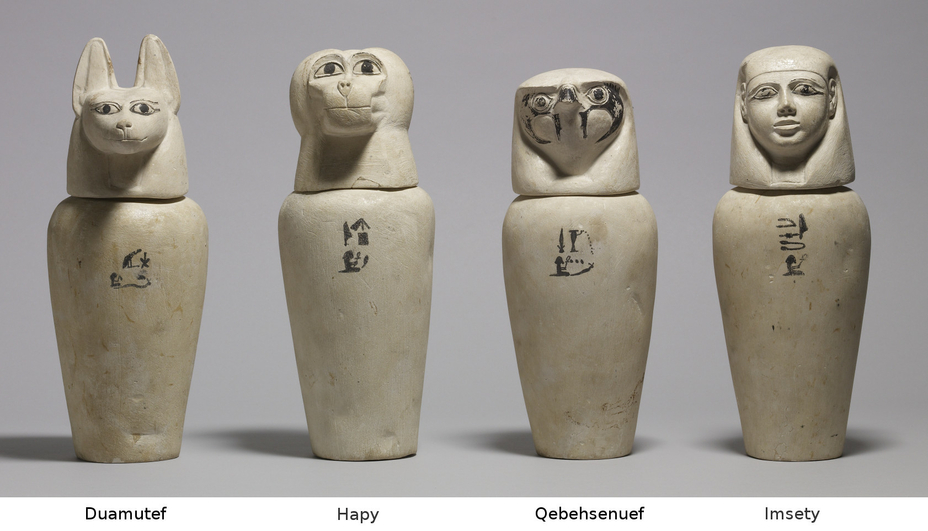
"A Complete Set of Canopic Jars" at the Walters Art Museum", 900-800 BCE (Third Intermediate Period), limestone with paint. "This set of canopic jars was made to contain the internal organs removed from the body during the mummification process. The four sons of the god Horus were believed to protect these organs. The jackal-headed Duamutef protected the stomach; the falcon-headed Qebehsenuef, the intestines; the baboon-headed Hapi, the lungs; and human-headed Imsety, the liver." https://art.thewalters.org/detail/77403/a-complete-set-of-canopic-jars/
34.12 The so-called "canopic jars"
"Canopic jars are containers that were used by the ancient Egyptians during the mummification process, to store and preserve the viscera of their owner for the afterlife. They were commonly either carved from limestone, or were made of pottery. These jars were used by the ancient Egyptians from the time of the Old Kingdom, until the time of the Late Period or the Ptolemaic Period, by which time the viscera were simply wrapped and placed with the body. The viscera were not kept in a single canopic jar: each jar was reserved for specific organs. The term canopic reflects the mistaken association by early Egyptologists with the Greek legend of Canopus – the boat captain of Menelaus on the voyage to Troy – "who was buried at Canopus in the Delta where he was worshipped in the form of a jar". In alternative versions, the name derives from the location Canopus (now Abukir) in the western Nile Delta near Alexandria, where human-headed jars were worshipped as personifications of the god Osiris."
"Canopic jars of the Old Kingdom were rarely inscribed and had a plain lid. In the Middle Kingdom inscriptions became more usual, and the lids were often in the form of human heads. By the Nineteenth Dynasty each of the four lids depicted one of the four sons of Horus, as guardians of the organs."
"Many Old Kingdom canopic jars were found empty and damaged, even in undisturbed tombs. Therefore it seems that they were never used as containers. Instead, it seems that they were part of burial rituals and were placed after these rituals, empty."
"By the late Eighteenth Dynasty canopic jars had come to feature the four sons of Horus. Many sets of jars survive from this period, in alabaster, aragonite, calcareous stone, and blue or green glazed porcelain. The sons of Horus were also the gods of the cardinal compass points. Each god was responsible for protecting a particular organ and was himself protected by a companion goddess. They were:
• Hapi, the baboon-headed god representing the North, whose jar contained the lungs and was protected by the goddess Nephthys. Hapi is often used interchangeably with the Nile god Hapi, though they are actually different gods.
• Duamutef, the jackal-headed god representing the East, whose jar contained the stomach and was protected by the goddess Neith
• Imsety, the human-headed god representing the South, whose jar contained the liver and was protected by the goddess Isis
• Qebehsenuef, the falcon-headed god representing the West, whose jar contained the intestines and was protected by the goddess Serqet."
"Early canopic jars were placed inside a canopic chest and buried in tombs together with the sarcophagus of the dead. Later, they were sometimes arranged in rows beneath the bier, or at the four corners of the chamber. After the early periods there were usually inscriptions on the outsides of the jars, sometimes quite long and complex"
https://en.wikipedia.org/wiki/Canopic_jar
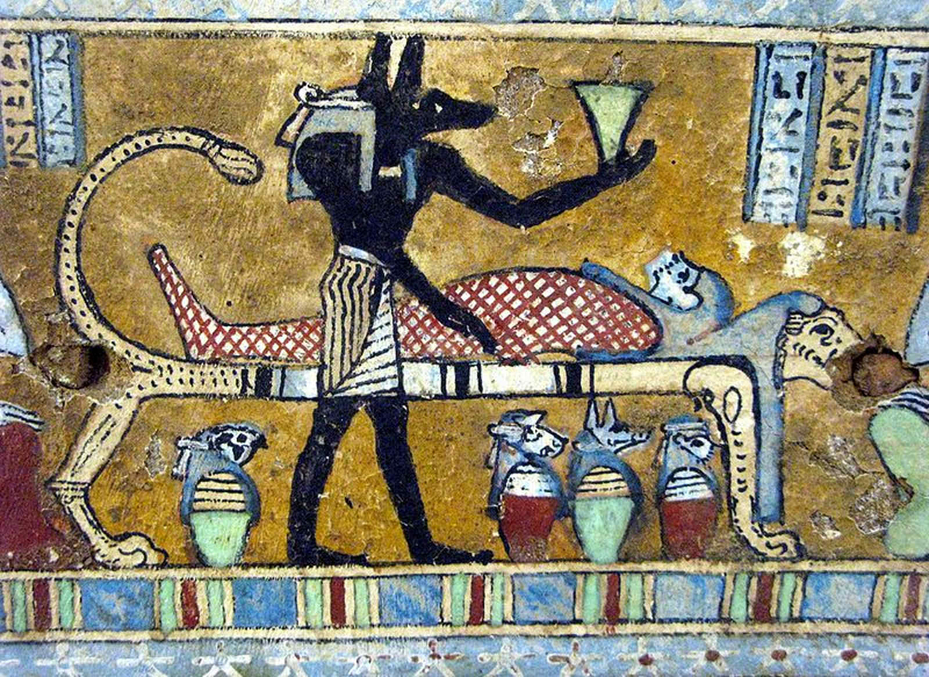
Image of the ancient Egyptian god of the Dead, Anubis "performing" the mummification process, showing the four canopic vases of Qebehsenuef (containing the intestines), Hapy (containing the lungs), Duamutef (containing the stomach) and Imsety (containing the liver), by André from Amsterdam: https://commons.wikimedia.org/wiki/File:WLANL_-_andrevanb_-_kist_uit_de_27-_31e_dynastie_(4).jpg
34.13 The long mummification process has been associated with the impactor's long and perilous trip
The whole point of the scene representing Anubis and the "lion-bed" on the above image is for the deceased who is lying on the bed, to mimic the "endless trip" of the impactor of the Great Pyramid. Here, Anubis is actually represented twice: the black headed jackal and the lion-headed bed are both representations of Anubis; they are both representations of the impactor's sledge (previous Sections 32 and 33).
In other words, the scene is about putting the sledge into motion: it is about the deceased to engage himself into the same endless but perilous trip of the impactor's.
34.14 The canopic jars are all about the "endless and perilous trip" of the impactor of the Great Pyramid
In short, the academic vision of the canopic jars is that they are here to protect the organs, and that the Four Sons of Horus represented onto the jars are responsible for protecting these organs.
Will see that this academic interpretation of the Four Sons of Horus "protecting" the organs, is not only incorrect but really the exact opposite of their real meaning.
To understand these canopic jars, the question of where they were placed is crucial: they were to be set under the bed of the deceased; a bed which we know now being the representation of the sledge which supported the impactor of the Great Pyramid (Section 32 and 33).
If the four canopic jars are directly associated to that sledge, it is because they are all directly referring to the endless operating cycle of the impactor. The canopic jars are about the endless and hazardous "trip" of the impactor, from its high speed dive in the Grand Gallery to the tremendous ramming impact with the inclined well waters.
34.15 The hazardous operating cycle "trip" of the impactor threatens the travelers' health: action must be taken
Even today, before going on a trip, travelers first have to prepare themselves against all the little health troubles they are gonna face during that trip; and that is the exact meaning of the canopic jars: the deceased is going on a very long trip towards immortality, a trip which is supposed to mimic the "endless trip" of the impactor of the Great Pyramid, and the organs inside the jars would have to be protected from all the health troubles they will have to face during the trip.
Will see that the Four Sons of Horus were not protecting the content of the jars, but that they were precisely representing these "health risks" that the deceased will have to face during the trip.
If some organs had been removed from the body and put into the canopic vases, it is because they needed to be protected from the dangers of the trip:
• the lungs needed to be protected from water entering respiratory tracts, that could cause pulmonary aspiration and drowning
• the stomach needed to be protected from seasickness
• the intestines needed to be "peaceful" and protected from the traveler's diarrhea
• the liver needed to be protected against over eating while "stuck in bed", and inactive
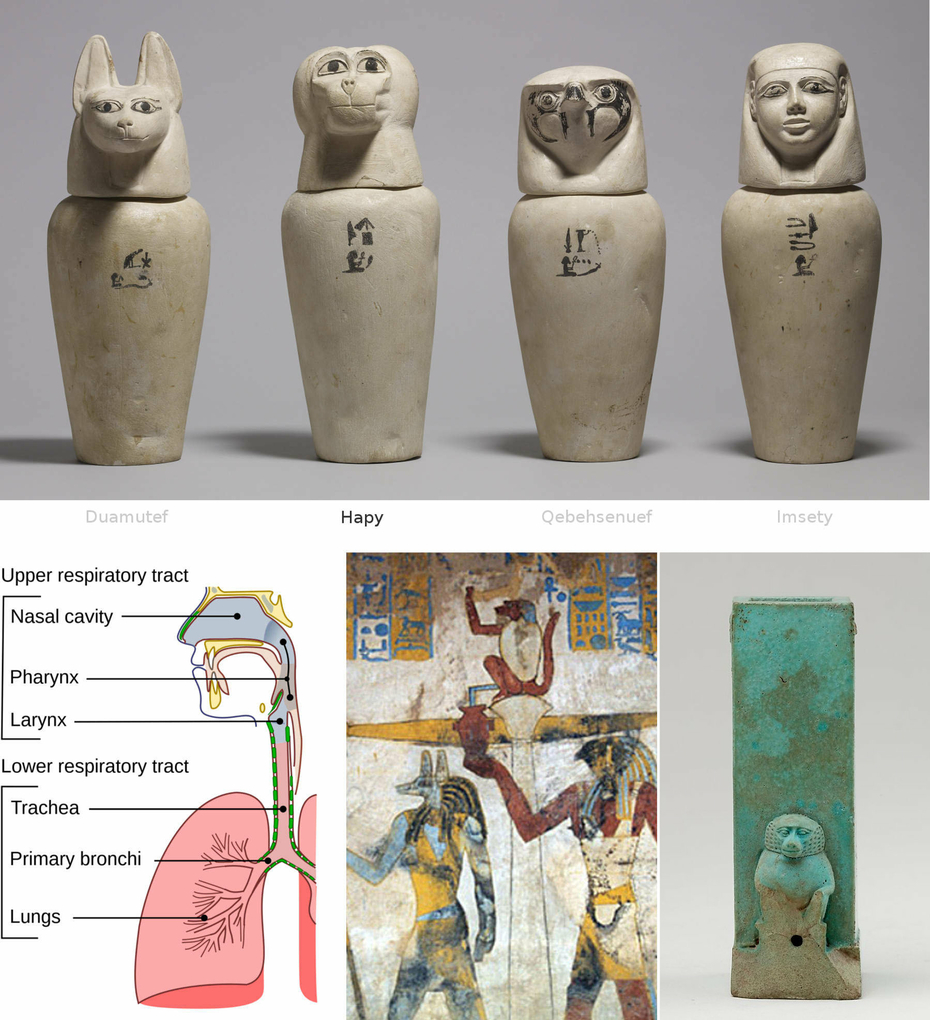
"Upper respiratory tract (pharynx and larynx) and lower respiratory tract (trachea, bronchi, and lung)", by Lord Akryl, Jmarchn: https://en.wikipedia.org/wiki/Pulmonary_aspiration#/media/File:Illu_conducting_passages.svg
"Clepsydra or water clock with squatting baboon", at the MET: https://www.metmuseum.org/art/collection/search/549190
34.16 1st traveler's health tip for the great trip through the operating cycle of the impactor: protecting the lungs from the water of Hapy, to avoid pulmonary aspiration and drowning
The baboon-headed Son of Horus Hapy was represented onto the cap of the canopic jars protecting the lungs, and he is also probably the easiest one to decipher.
We've already seen that the baboon has been one way for ancient Egyptians to metaphorically represent the water they used in their technological program, as shown on so many water clocks and the "peeing" baboon in one of the weighing of the heart scene (Section 20: https://www.milleetunetasses.com/blog/the-pyramids-of-the-cold/the-weighing-of-the-heart.html)
So, if this particular canopic jar associated with a baboon is about the idea of protecting the lungs, and at the same time we know the baboon is all about water… it doesn't take a masters degree in physiology to understand that the real function of this jar is about protecting the lungs from some water trying to get into these lungs.
The baboon-headed Son of Horus Hapy is not here to protect the lungs in the jar: he is the danger; he is the risk from which the lungs need to be protected from.
And indeed, the endless cycle of operation of the impactor involved water both during its high-speed dive in the Grand Gallery (Hapy "the Great Runner" who was the glorification of the water used to lubricate the sledge runners into their tracks, previous Section 33), as well as the waters of the inclined well itself (the primordial waters Nun who became pressurized water Apep from the impact).
In short, the "peeing" baboon-headed Son of Horus Hapy represented onto the canopic jar protecting the lungs, is representing the water which is susceptible to enter respiratory tracts and cause pulmonary aspiration and drowning.
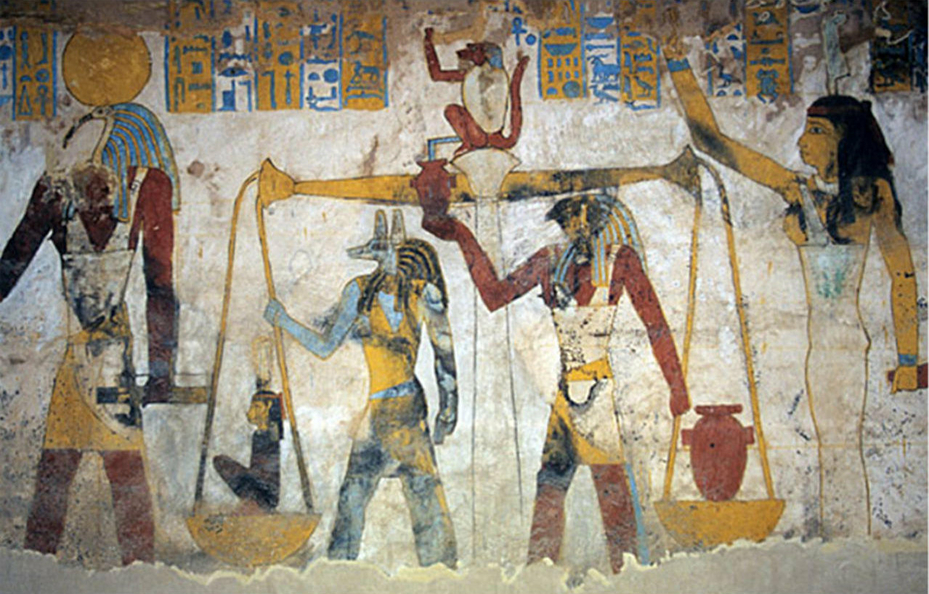
The Weighing of the Heart Justice scene ceremony in the sarcophagus chamber of the tomb of Baennentiu, Qarat Qasr Salim, el-Bahriya depression, Libyan desert, Egypt. Photograph courtesy of Roland Unger and posted on Wikipedia : "Justice scene: tomb owner Baennentiu conducted by Maat, Anubis and Horus with scales, Thoth, right wall in the sarcophagus chamber of the tomb of Baennentiu." https://upload.wikimedia.org/wikipedia/commons/3/39/BawitiSelimBanentiuSanctRight.jpg
34.17 Gods used as simple basic tools
We've already seen with the magnifying glass represented in a relief of the Dendera temple, that the Eye of Horus had been used only because it was an eye: the Eye of Horus, the Eye of Ra or the Eye of anybody would have done the trick the same way; they simply needed an eye, and they used what they've already created.
Same thing here: they simply needed to represent water, so they used the baboon-headed Son of Horus Hapy, as a simple tool; like we would use yellow paint to represent the sun or blue paint to represent the sky.
Anyway, with this deciphering "health risks of the traveler" template regarding this particular canopic jar, we can now find out the real meaning of the three other canopic jars.
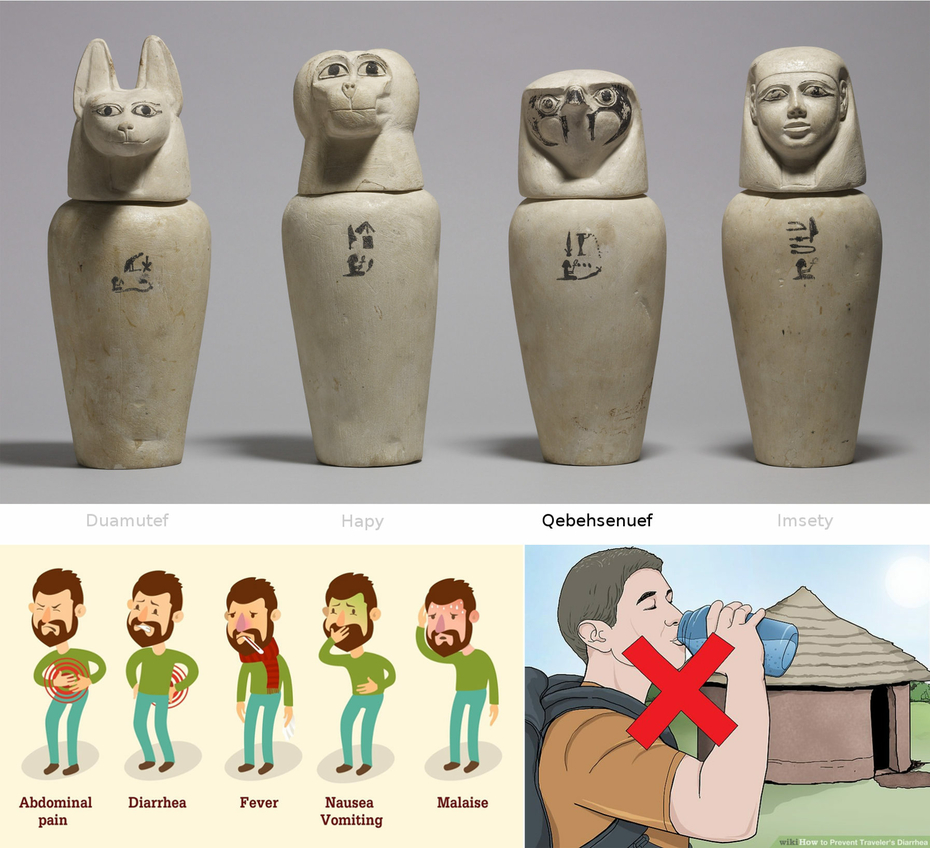
SIBO Doctors (Small Intestinal Bacterial Overgrowth): http://www.sibodoctors.ca/blog/2016/9/15/sibo-travelers-diarrhea
34.18 2nd traveler's health tip for the great trip through the operating cycle of the impactor: don't drink unfiltered water for a peaceful intestine, protected from irritable bowel syndrome and traveler's diarrhea of Qebehsenuef
The metaphor here is about the "high-speed" dive of the falcon Son of Horus Qebehsenuef, and I will not even try to explain that metaphor; we've all been through diarrhea at home or abroad, we all know how it feels.
The message is still about water, but here it is clearly about "unfiltered" water: "do not drink unfiltered water if you want peaceful intestines!"
"Avoid drinking the tap water in developing countries. The tap water in developing countries in Central and South America, the Middle East, Africa, and Asia may be contaminated with bacteria, parasites, and viruses. These can all cause traveler’s diarrhea (TD). When visiting these areas, only drink sealed, bottled beverages like bottled water, tea, soda, beer, wine, juice, and coffee."
How to Prevent Traveler's Diarrhea: https://www.wikihow.health/Prevent-Traveler%27s-Diarrhea
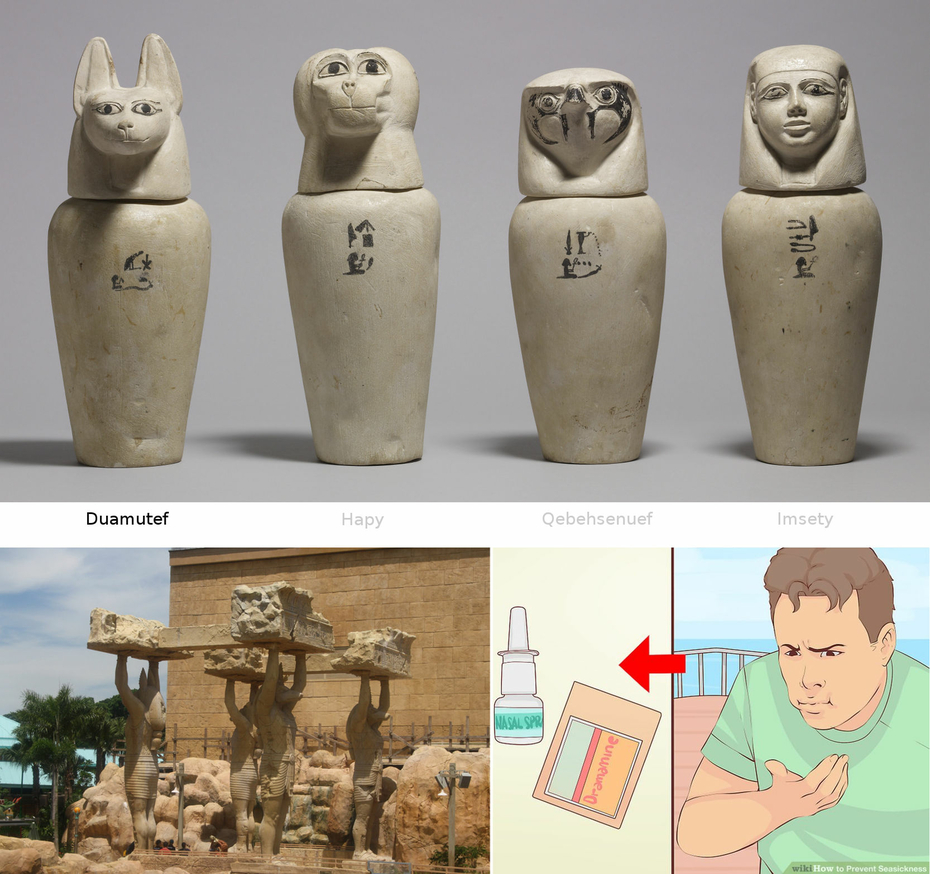
Giant size replicas of Ancient Egyptian god Anubis statues at Universal Studios, Singapore.
"How to Prevent Seasickness", on wikiHow: https://www.wikihow.health/Prevent-Seasickness#/Image:Prevent-Seasickness-Step-14.jpg
34.19 3rd traveler's health tip for the great trip through the operating cycle of the impactor: a peaceful stomach protected from the Duamutef motion sickness and seasickness
With the jackal-headed Son of Horus Duamutef represented on the canopic jar protecting the stomach, the metaphor used by ancient Egyptians is the "lifted in the air" stomach that causes nausea and vomiting.
By being protected into the jar from what represents the jackal, as the giant statues of Anubis are clearly demonstrating on the above image, the traveler guarantied himself a peaceful stomach, protected from motion sickness or seasickness.
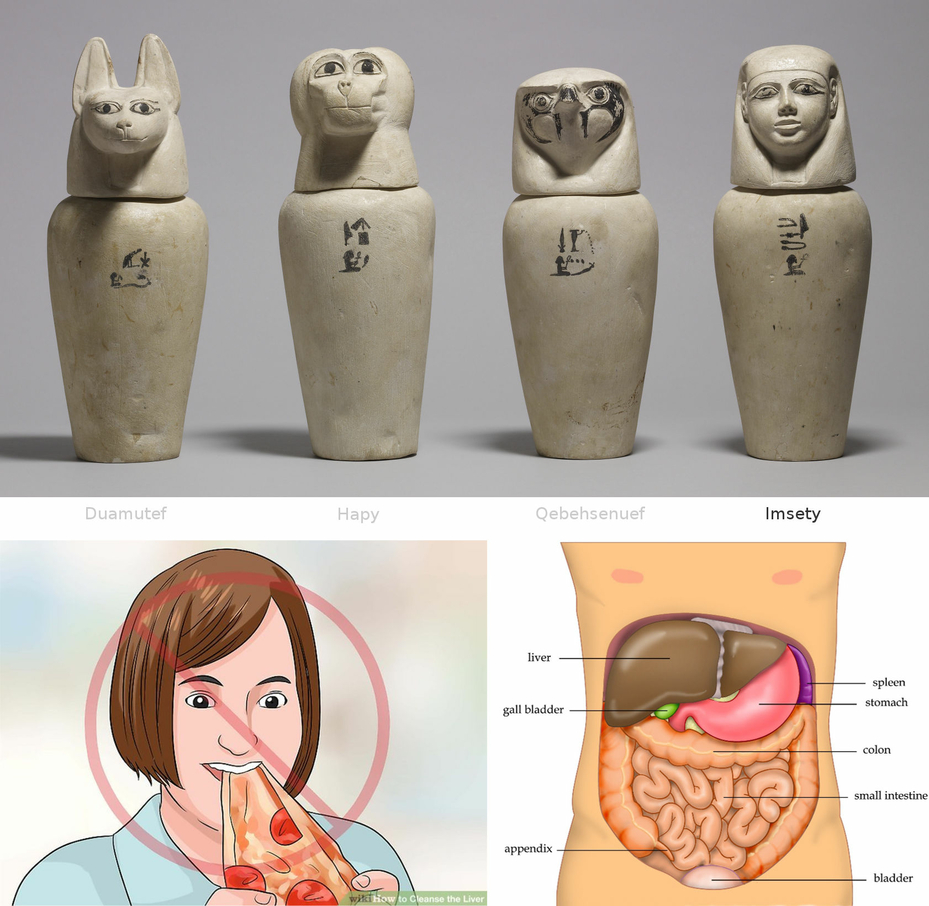
"How to Cleanse the Liver": https://www.wikihow.com/Cleanse-the-Liver#/Image:Cleanse-the-Liver-Step-7-Version-3.jpg
Anatomy of the abdomen in a human body: https://en.wikipedia.org/wiki/Liver#/media/File:Anatomy_Abdomen_Tiesworks.jpg
34.20 4th traveler's health tip for the great trip through the operating cycle of the impactor: a peaceful liver protected from bad eating habits caused by your best friend Imsety
The fourth canopic jar representing the human-face Son of Horus Imsety, is for the protection of the liver and very interestingly, the liver is also a filtering organ.
To this day, I would say Imsety is not just anybody, but probably the representation of the "best friend", the one friend with whom you are susceptible to drink too much and eat too much. By doing so, you would damage your liver, and of course you need to be protected from him as well
"The liver is the second largest organ in the human body and one of the most important, because it's responsible for filtering harmful toxins out of the bloodstream." "How to Cleanse the Liver": https://www.wikihow.com/Cleanse-the-Liver
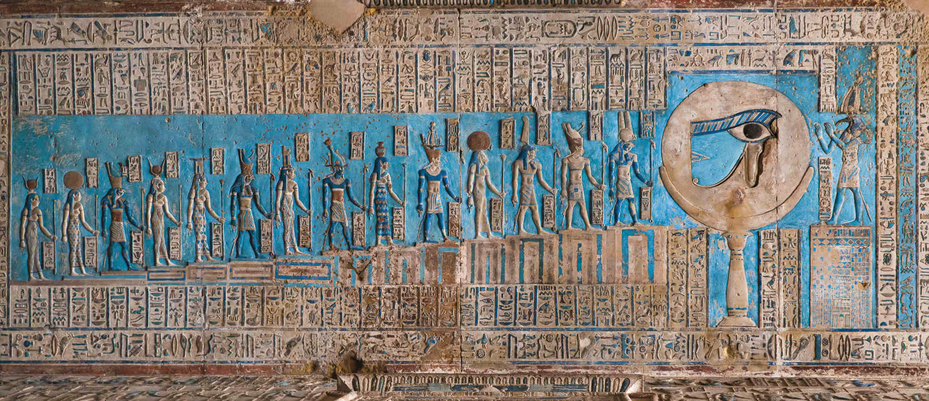
"The astronomical ceiling at the Pronaos, outer hypostyle hall in the Temple of Hathor in the Dendera Temple complex, near Dendera, Egypt.: first Band west from the centre, showing the full healed moon on a pillar depicted as "Wadjet" the Eye of Horus healed by Thoth, who is portrayed at the right." Thanks to Kairoinfo4U : https://www.flickr.com/photos/manna4u/9295311496
34.21 Is the Egyptian blue the glorification of natron itself?
For those who've already read the previous Sections of the study, you know that my big concern now is to know if the creation of the cold was a "simple" scientific demonstration or if it was created to cool down chemical manufacturing of sodium carbonate "natron" by a Solvay-like process; except for the representation of a Djed pillar receiving the Dendera Light, suggesting the cold would have been used for a Solvay tower, I found nothing else that would confirm this Solvay hypothesis.
But I just found out that the famous blue color, the "Egyptian blue" as we call it, was actually made with natron; so it is possible that the proof of the Solvay process is right under our own very eyes, and it is literally everywhere. It is possible that Ancient Egyptians didn't try to hide the Solvay process, but that they were actually showing it everywhere: the Egyptian blue could be the glorification of the Solvay process I was looking for!
"Egyptian blue, also known as calcium copper silicate (CaCuSi4O10 or CaOCuO(SiO2)4 (calcium copper tetrasilicate)) or cuprorivaite, is a pigment that was used in ancient Egypt for thousands of years. It is considered to be the first synthetic pigment." https://en.wikipedia.org/wiki/Egyptian_blue
"Natron is an ingredient for making a distinct color called Egyptian blue, and also as the flux in Egyptian faience. It was used along with sand and lime in ceramic and glass-making by the Romans and others at least until AD 640. The mineral was also employed as a flux to solder precious metals together." https://en.wikipedia.org/wiki/Natron
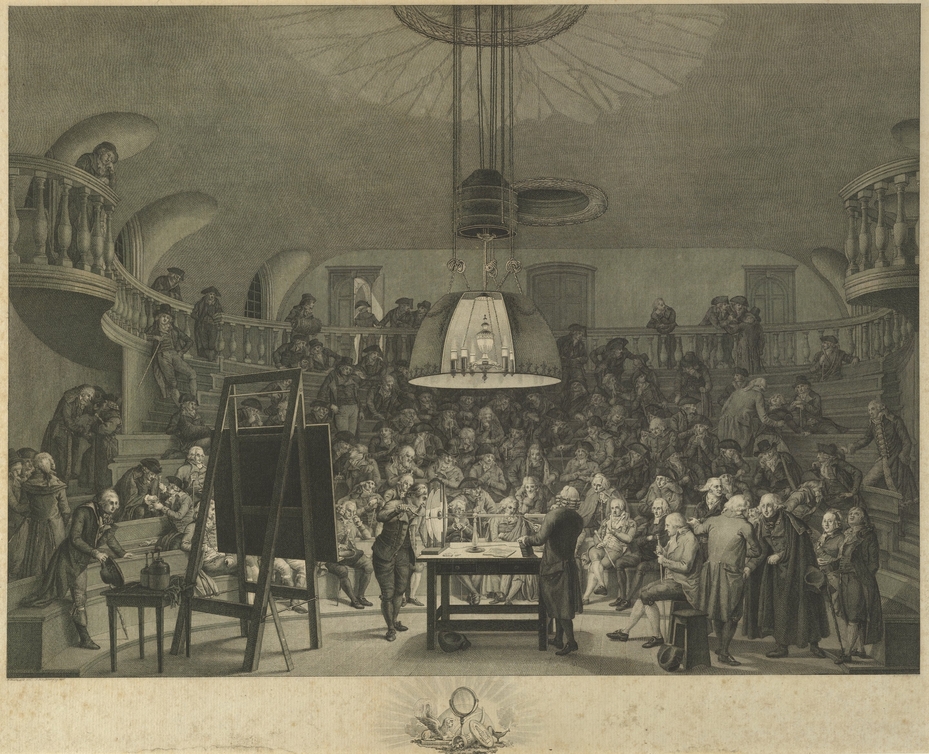
"This engraving shows Dutch mathematician and physicist Jean Henri van Swinden (1746–1823) demonstrating the generation of electricity to the Felix Meritis Society in Amsterdam. The Felix Meritis Society was founded in the late 18th century to promote the arts and sciences (Felix Meritis translates as "Happiness through Merit")". Barbiers, Pieter Pietersz., and Jacques Kuyper. Laid paper, 1800–1899. Science History Institute, Philadelphia U.S.A.: https://digital.sciencehistory.org/works/zg64tm573
34.22 The profound demonstrating meaning of the scene representing god of Science Thoth in front of all the other gods
I've used this image many times, but what I want to point out here, is how good is the analogy between this perfect illustration of demonstrating science in the 1800s, compared to the illustration of Thoth in the Dendera "temple"; they are not just similar, they are exactly the same: Thoth is demonstrating his knowledge in science through the magnifying glass, and towards all the other gods assembled in front of him, just like Dutch mathematician and physicist Jean Henri van Swinden is demonstrating the generation of electricity to the Felix Meritis Society in Amsterdam.
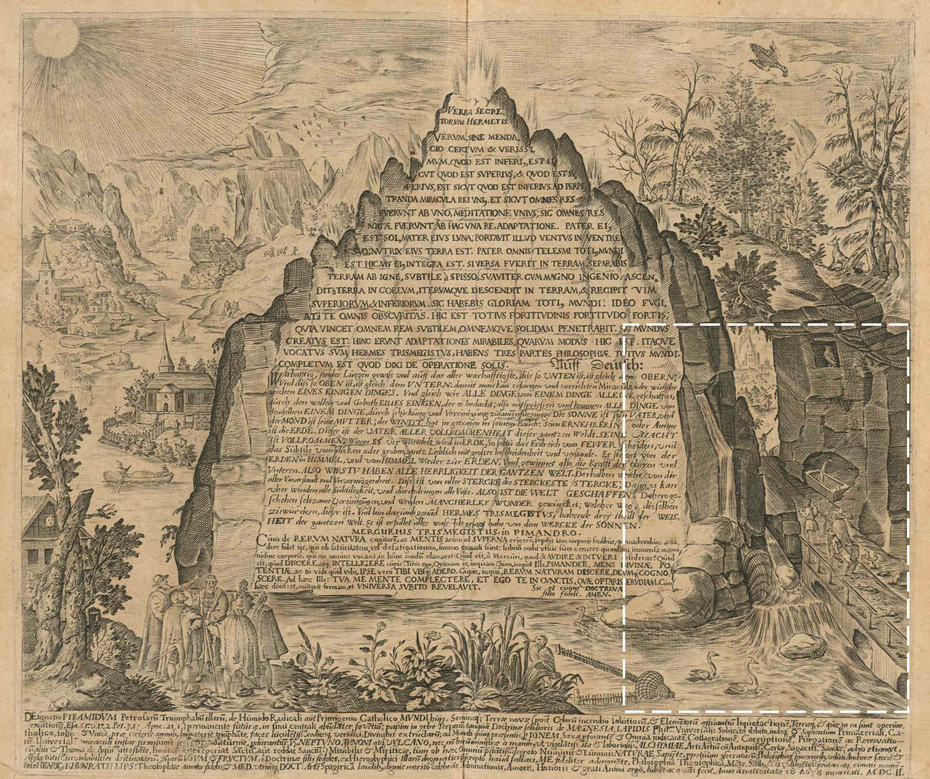
"An imaginative 17th-century depiction of the Emerald Tablet from the work of Heinrich Khunrath (1560-1605)" : https://en.wikipedia.org/wiki/Emerald_Tablet
34.23 The "technical" and "religio-philosophical" Hermetica (inspired by ancient Egyptian god of science Thoth)
Maybe the most basic characteristic of this study, and which appeared little by little, month after month since January 2021, is the fact that the deciphering of the ancient Egyptian civilization only occurs if you engage yourself in a dual composite representation:
• a technical approach of what really happened in the first pyramids and mastabas of the first Dynasties, until the Great Pyramid was built
• a religious approach in which all the technical approach has been "encoded" into myths, gods and goddesses
This double approach is also the chore of the Hermetica; texts which are originating as far as ancient Egypt, and refer in particular to the ancient Egyptian god of science, Thoth:
"The Hermetica are texts attributed to the legendary Hellenistic figure Hermes Trismegistus, a syncretic combination of the Greek god Hermes and the Egyptian god Thoth. These texts may vary widely in content and purpose, but are usually subdivided into two main categories, the "technical" and "religio-philosophical" Hermetica. [...] It may even be the case that the great bulk of the early Greek Hermetica were written by Hellenizing members of the Egyptian priestly class, whose intellectual activity was centred in the environment of Egyptian temples." https://en.wikipedia.org/wiki/Hermetica
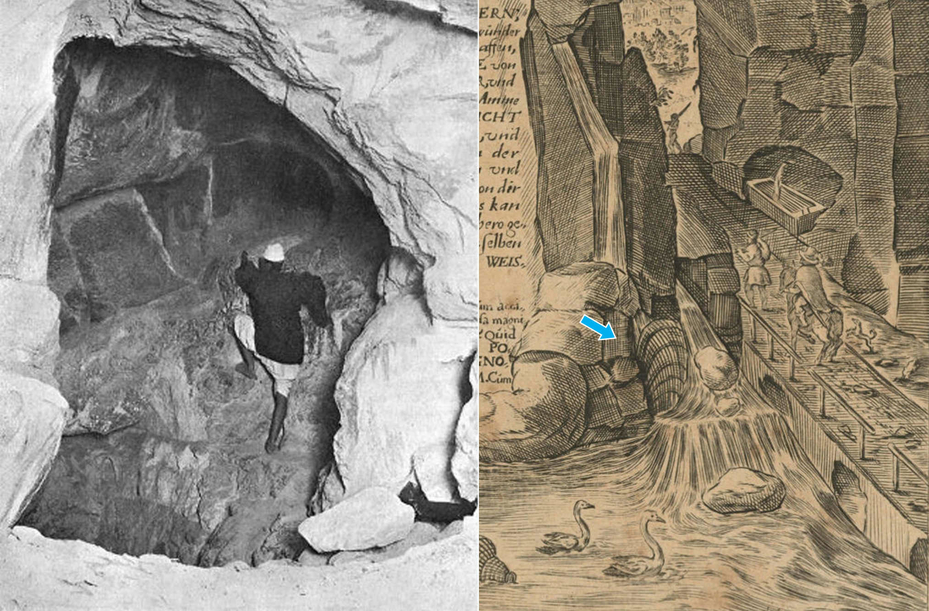
The cavity of Al-Ma'mun only served the purpose of collecting the inclined well waters for the shutdown procedure of the pyramid. The draining of the well was triggered by the breaking of the wedging block (represented in the Bes deity) that was supporting what is now known as the upper granite plug of the ascending passage, and that was represented in the Taweret hippopotamus deity.
Photograph of the cavity of Al-Ma'mun : "Great Pyramid Passages, Volume 1, by John and Morton Edgar, 1910" : Plate LXIV, page 166 : https://archive.org/details/GreatPyramidPassagesVol11910Edition/page/n174/mode/1up
34.24 The draining of the inclined well into the al-Ma'mun cavity
If the Hermetica texts are very "obscure", the above illustration made by Heinrich Khunrath in the 17th century is a lot more interesting, because believe it or not, as crazy as it looks like, the guy more than 400 years ago depicted the entire sequence of the operation of the inclined well, starting with the biosand filter "sarcophagus" to the draining of the well into the Al-Ma'mun cavity. How about that!
It is actually weird, because it all starts at the extreme right side of the picture, and then "chronologically", the operating cycle is described little by little, by simply going towards the center of the image where is the mountain, which by the way is getting very close to look like a pyramid.
• at the extreme right is the representation of the biosand filter, in its dedicated little "grotto" (the "electric room").
• then is the representation of the Grand Gallery with its hauling slope and the hauling horse (in 17th century Germany, horses were most probably better illustrations of hauling animals than the ancient Egyptian cows).
• then is the representation of what triggered the draining of the well with these 2 big and one small rocks inside the water flow. The upper big rock is of course Taweret, released from its original position when the wedging block broke under increased pressure (they most probably simply flooded the central wooden caisson to increase the water height, hence the pressure onto Taweret); of course the little rock in between the two big rocks, is the upper part of the broken Bes wedging block; and finally we have the second big rock, the "shock absorber" block deified into "the Savior" by ancient Egyptians: look how "proud" it looks like, waiting to do its job, standing in front of the two other ones.
And to show that the little block was initially supposed to be a fixed wedging block, it has even been set onto a little flat area within the river.
• finally, we have the draining of the well itself, in a perfect representation of the Al-Ma'mun cavity and its distinguishable shape of a funnel.
More on the draining of the well in Section 8

34.25 The operating cycle of the Great Pyramid of Egypt, for evaporative cold production and (hypothetically) for cooling down chemical manufacturing of sodium carbonate "natron" by a Solvay-like process.
34.26 Did Heinrich Khunrath really knew he was depicting the operation of the Great Pyramid?
The problem now is very simple: did Heinrich Khunrath in the 17th century, really knew what he was depicting; did he understood that it was all about the operation of the Great Pyramid or did he simply reproduced something which was circulating in the 17th century?
Today, millions or billions of people are playing with the heart symbol all over the world without the slightest clue that they are actually referring to the mighty inclined well of the Great Pyramid; is it possible that Heinrich Khunrath did the same thing? Would he have implement so many details of the Pyramid if he didn't know their real significance? I have no idea.
We've already seen how much influence the Great Pyramid had on the Norse mythology (Thor, Section 22), the Hindu mythology (The Churning of the Ocean, Section 19) and the Maori Haka ceremonial dance (Bes, Section 7); so there is nothing surprising in finding influence in Europe as well.
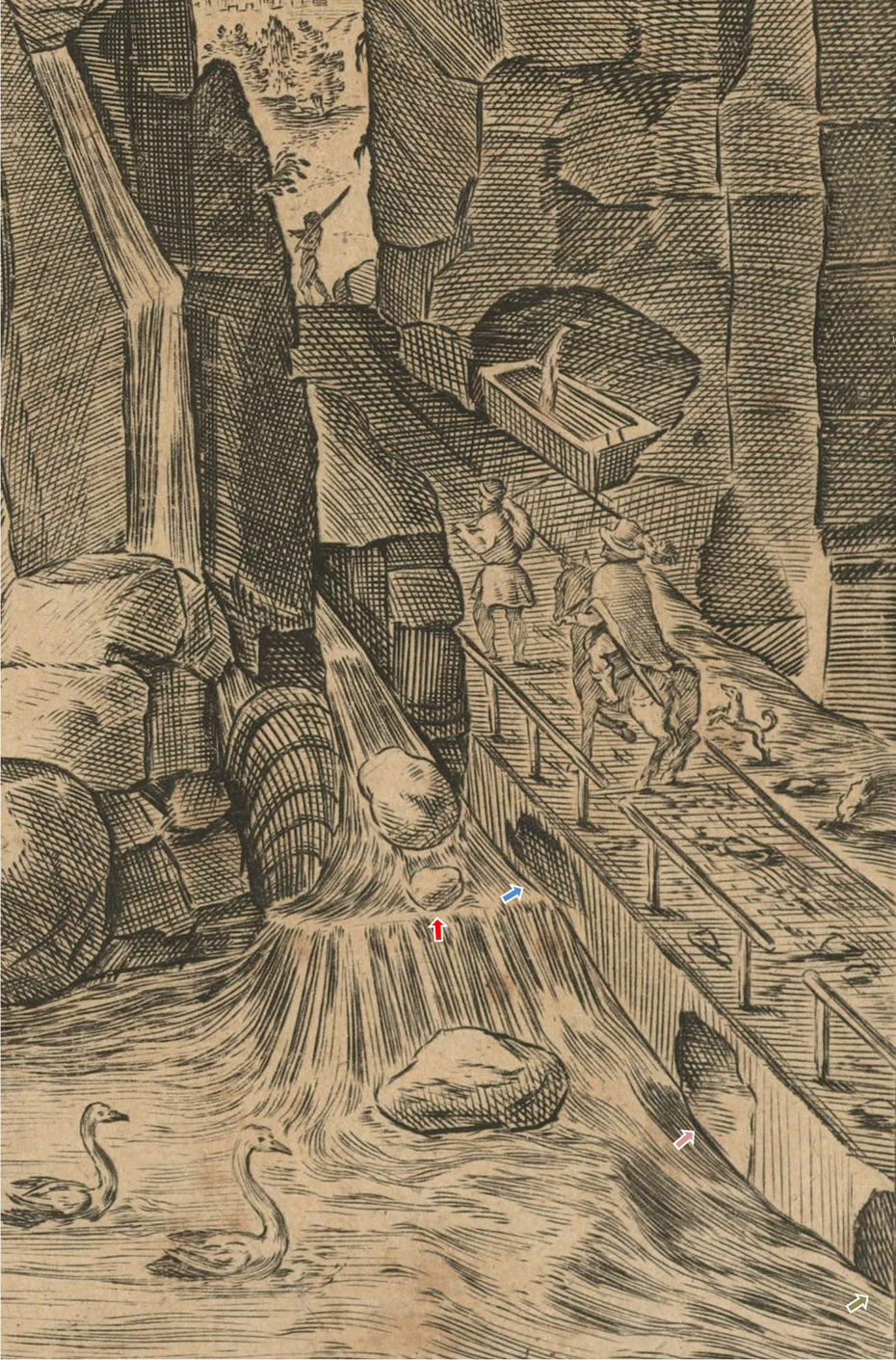
34.27 The original position of the granite plug number 2 "shock absorber" block for Taweret's immobilization
Also, if it is true that the third big block, which is granite plug number one in the Operating Diagram of the Great Pyramid, isn't represented in the water with the three other blocks, if you look at the bank of the "river", you will see it: the three granite plugs of the inclined well are right there; because don't forget that this particular block never touched the water… ever!
Why would anyone have represented this block directly into the water of the river if it never touched the waters of the well?
But, if you look just at this part of the illustration, the bank of the river with the three kind of "rectangular shades" into it, and the slope of this bank, doesn't it looks exactly like my diagram?
And here is maybe the most amazing part of this Section: because of this illustration of the bank of the river, we know now the exact position in which was set granite plug number 2 "the Savior" shock absorber block, in the ascending passage and during the entire operation of the Great Pyramid. How about that!
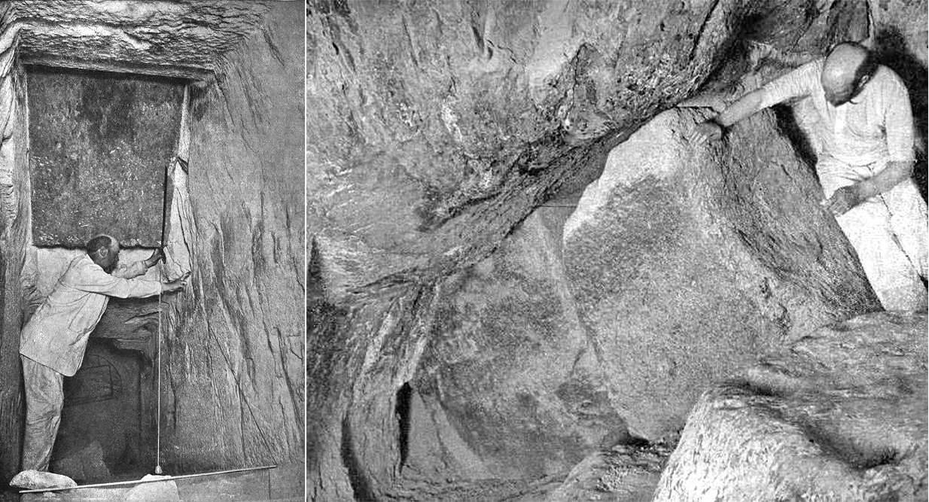
"The lower butt-end of the granite plug which blocks the entrance of the First Ascending Passage of the Great Pyramid of Gizeh ; showing the space in the roof of the Descending Passage which was formerly occupied by an inset limestone block, which covered the Granite Plug and hid the entrance of the First Ascending Passage, and thus for three thousand years kept secret the existence of the upper passages and chambers of the Pyramid."
Great Pyramid Passages Vol 1 1910 edition, by John and Morton Edgar. Plate LXVIII page 172: https://archive.org/details/GreatPyramidPassagesVol11910Edition/page/n180/mode/1up
Plate LXIX, page 173; full image at: https://en.wikipedia.org/wiki/Great_Pyramid_of_Giza#/media/File:49_edgar.jpg
34.28 Granite plug number 1 was "half in the passage and half out of the passage", so its representation in the Emerald tablet is "half in the picture and half out of the picture" as well
One can think that this illustration of the Hermetica, called the Emerald tablet is a very naïve representation but it really is not. Everything has been perfectly thought through, just like ancient Egyptians when they've created their own glorification propaganda.
The lower "shadow" that looks like a rock encrusted inside the bank of the river is a perfect example of this: one can think it is half out of the picture by accident, but it really is not; and because again, this block is the lower granite plug of the ascending passage. Not only there is only the "shade" of this granite plug number 1 block into the bank of the river because this block never touched the waters of the well, but this block also had one part inside the "passage" and the other part outside the "passage", visible from the descending passage as we can see on the picture of the Edgar brothers.
34.29 The Emerald tablet text really is about an endless cycle of slow ascent and hasty descent
The fact that this illustration of the Emerald tablet is describing the operation of the Great Pyramid brings another question now: is the text accompanying the tablet also about the Pyramid?
And the answer is yes: the text really is about the endless cycle of ascending "gently in the heavens" and "descending hastily" from these same heavens. I only found this "hastily descent" in a French translation of the texts; but in the illustration, there really is the representation of a bird engaged in a high speed dive, just like the falcon god Horus would do as the impactor.
"Truth! Certainty! That in which there is no doubt! That which is above is from that which is below, and that which is below is from that which is above, working the miracles of one [thing]. As all things were from One. Its father is the Sun and its mother the Moon. The Earth carried it in her belly, and the Wind nourished it in her belly, as Earth which shall become Fire. Feed the Earth from that which is subtle, with the greatest power. It ascends from the earth to the heaven and becomes ruler over that which is above and that which is below."
"The father thereof is the Sun, the mother the Moon. The wind carried it in its womb, the earth is the nurse thereof.
It is the father of all works of wonder throughout the whole world. The power thereof is perfect. If it be cast on to earth, it will separate the element of earth from that of fire, the subtle from the gross. With great sagacity it doth ascend gently from earth to heaven. Again it doth descend to earth, and uniteth in itself the force from things superior and things inferior. Thus thou wilt possess the glory of the brightness of the whole world, and all obscurity will fly far from thee. This thing is the strong fortitude of all strength, for it overcometh every subtle thing and doth penetrate every solid substance". https://en.wikipedia.org/wiki/Emerald_Tablet
"Le soleil en est le père, la lune est sa mère, le vent l’a porté dans son ventre ; la Terre est sa nourrice. Le père de tout le telesme de tout le monde est ici. Sa force ou puissance est entière, si elle est convertie en terre. Tu sépareras la terre du feu, le subtil de l’épais doucement, avec grande industrie. Il monte de la terre au ciel, et derechef il descend en terre" https://fr.wikipedia.org/wiki/Table_d%27%C3%A9meraude
In this French version of the "la table d'émeraude", "derechef" means "quickly, hastily".
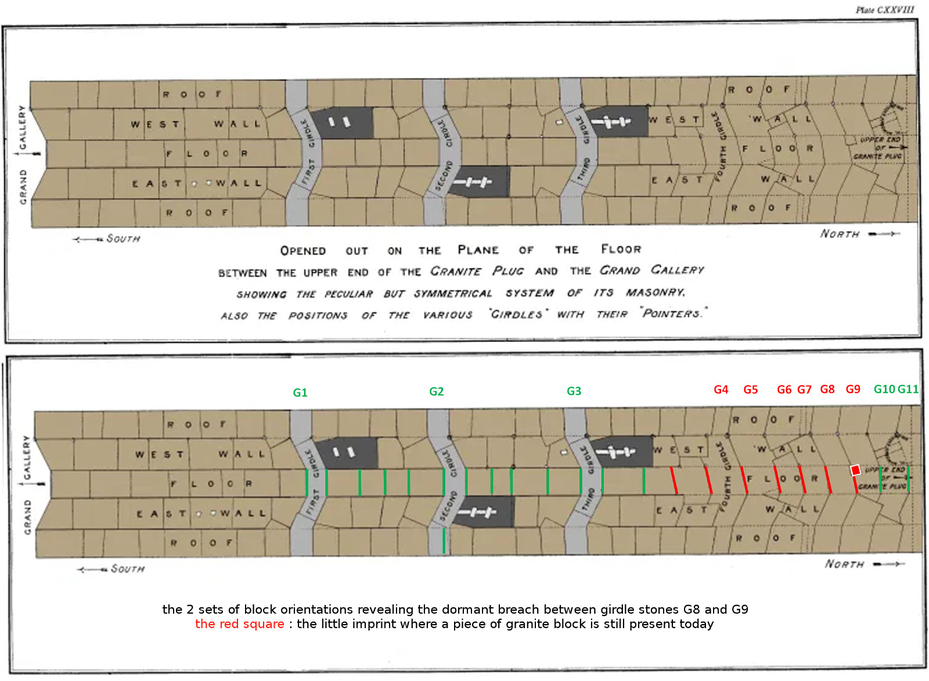
Original diagram of the First Ascending Passage, by John and Morton Edgar, in "Great Pyramid Passages, Volume 1 (1910 edition)", plate CX, paragraph ref. 460, page 230 : https://archive.org/details/GreatPyramidPassagesVol11910Edition/page/n239/mode/2up
34.30 The layout of the girdle stones of the inclined well of the Great Pyramid of Giza (top view)
If I'm mentioning the "forgotten" girdle stones, it is only because after having perfectly described these "forgotten" girdles, the Edgar brothers decided not to include them in their interpretation of the Great Pyramid's deciphering, simply because by being all "in contact with one another".
The Edgar brothers were only interested in finding distances between blocks in order to associate these distances to some historical events related to the Bible; and for that reason, all the lower girdles were of no use for them. Instead they used the three upper (half) girdles, and since everybody did the same thing, sometimes including the first of these forgotten girdles as there is a measurable distance between G3 and G4.
Excerpts are from "Great Pyramid Passages, Volume 1, by John and Morton Edgar 1910", sections 460 to 470: https://archive.org/details/GreatPyramidPassagesVol11910Edition/page/n239/mode/2up
• Section 462, talking about the girdle stones : "Before leaving home we had recognized the importance of the three upper ones as marking important dates in the Law Dispensation".
• Section 467 : "Those Girdles which lie lower down the passage than the three just described, are all in contact with one another".
• Section 468 : "it would seem that the stones which form the Girdles here were originally built in solid, end to end, after which the bore of the passage was cut through them. Above the fourth Girdle, however, there can be no doubt that the passage was constructed in the usual way, i.e., that the floor was first laid, the walls erected at the proper distance apart on the floor, and the roof- stones then placed on top of the wall-stones".
More on the structural specifications of the ascending passage, revealing that the passage was (partially) flooded, in Section 4
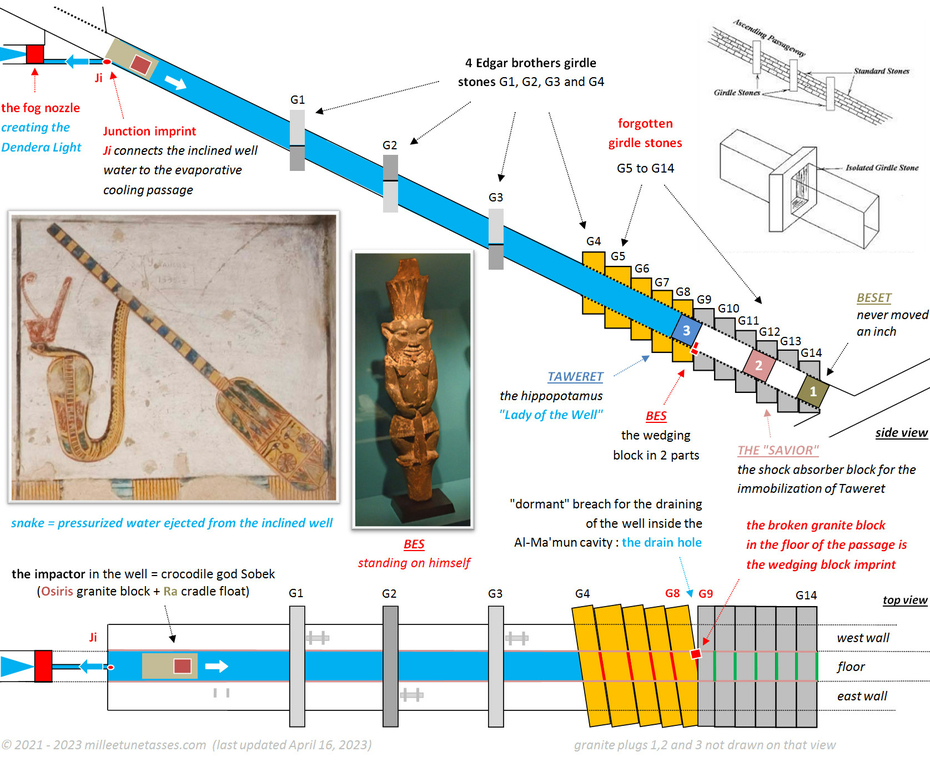
34.31 The original positions of the 3 granite plugs of the ascending passage of the Great Pyramid
Last updated, April 14, 2023. Granite plug number 2 "shock absorber" block for the immobilization of the Taweret block after its release, has been slightly moved up in the passage in accordance with the Emerald tablet representation.
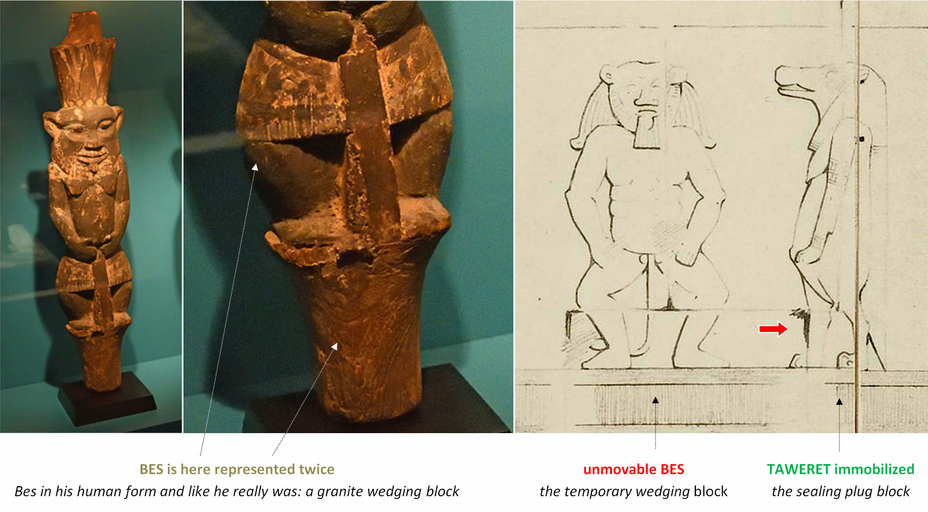
On this incredible picture, the wedging block is actually represented twice : not only we have the original design of the real block, but we have also its metaphorical representation in the god Bes. Image courtesy of Dosseman, from Two Bes-shaped legs for a bed, wood, New Kingdom : https://commons.wikimedia.org/wiki/File:Allard_Pierson_Museum_Bes_Legs_for_bed_7603.jpg
Hatshepsut’s birth scene, from Édouard Naville "The Temple of Deir el Bahari" (London, 1896), volume. 2, plate. 50. Image courtesy of the University Library Heidelberg, "The Ebony shrine, northern half of the middle platform": https://digi.ub.uni-heidelberg.de/diglit/naville1896bd2/0050
More on the Bes wedging block which was anchored in the floor of the ascending passage and maintained the Taweret block in position during the entire operating of the Great Pyramid, in Section 7
34.32 Summary of the study: hidden behind the academic vision of the ancient Egyptian religion, a vast number of metaphors are describing some of the most advanced science and technological knowledge of that time : ancient Egyptian gods were nothing else than pharaohs' metaphoric self-glorifications of their theoretical and experimental scientific accomplishments in physics and chemistry.
Pharaohs used the power of Science to legitimate themselves as kings of Egypt : they forged an entire religion, based on science to rule their kingdom, and they presented that science as Magic.
The end game of this technological program that probably started on the very first Dynasty, was the Great Pyramid of Giza where evaporative cooling was engineered in the known part of the pyramid from the pressurized water produced in the inclined well, known today as the ascending passage.
The evaporative cold simply took advantage of the power of water, and was most probably necessary to cool down chemical manufacturing of sodium carbonate and sodium bicarbonate produced by an ammonia-soda Solvay process, as suggested by the very strong ammonia smell and the limestone kiln in the so-called burial chamber of the Red Pyramid. At that time, sodium carbonate was called natron, and it was the salt used for the mummification of the pharaohs (Sections 14, 15 and 16).
The cooling seems to have represented the most difficult part of the process, as suggested by the Step Pyramid's official name : according to scholars, the very first pyramid complex, the Step Pyramid of Djoser, was called "the refreshment of the Gods". No doubt that a more accurate translation would certainly be "the cooling of the Gods".
It means that ancient Egyptians were the first civilization to master a Solvay-like process for sodium carbonate manufacturing, long before it got reinvented in the 1800's in Europe. The key elements of that process is the temperature control of the chemical reactions (the cooling), and the dome shaped plate necessary for the counterflow chemical reactions to occur in an efficient way. That counterflow reaction plate is what really is the disc of Sabu.
As shown with Akhenaten and Nefertiti, the creation of the evaporative cold was the most sacred accomplishment of all (Section 17), and this is exactly what the Dendera Light is all about : the Dendera Light is the fog of microdroplets of liquid water that evaporates and creates the cold. Talking about the snake inside the Dendera Light Bulb : "The field surrounding Ra’s snake form is referred to in ancient Egyptian literature as protective magical energy in liquid form that all gods and pharaohs possess" (Faulkner, Section 2).
Everything that had been done in the Great Pyramid of Giza inspired most of the ancient Egyptian religion, and it had been glorified into what we know today as the Underworld.
The Underworld is referring to the chambers and passages of the Great Pyramid of Khufu, and in particular to the Grand Gallery where a hauling gantry beetle operated a wooden coffin shaped impactor that had a small nested granite block inside it. The impactor generated endlessly, over and over, maybe every 15 minutes the pressurized water that was then transformed into a fog of microdroplets inside the horizontal cooling passage.
The Grand Gallery of the Great Pyramid where the act of hauling was done, is the "Secret Hauling Cavern of the Underworld" described in the Amduat "Book of the Hidden Chamber".
The most important chamber of the Great Pyramid wasn't the King's chamber that only was the main water tank of the pyramid, but the Queen's chamber, the only one on the central axis of the pyramid. Because the Queen's chamber was inaccessible from the rest of the pyramid, it was glorified into the "Hidden Chamber of the Underworld" (Section 11), and because the Queen's chamber was the coolest place in the pyramid (about 5°C / 41°F), and with a constant 100% Humidity rate, this chamber was the one where the biggest amount of very hard salt encrustation had been documented by the first explorers of the pyramid in the 1800's and before it had been removed in 1998 by Zahi Hawass (Section 1). Very hard salt encrustation is the signature of the evaporative cooling process, even nowadays.
The most incredible thing is that pretty much everything I've just said, actually appears in many myths, and they don't even originate from ancient Egypt : the "Churning of the Ocean" Hindu myth that produces the immortal nectar Amrita, the Tibetan Prayer Wheels operated to give small amounts of 'merit' to too lazy Naga snakes, and the entire Norse mythology with Thor's magical hammer endlessly fighting another Great Serpent of the Underworld and producing a mist of cold from a mysterious well that would be opposed to hellishly hot heat waves.
I'm talking a lot about the impactor of the Great Pyramid, but it is nothing compared to the tremendous impact caused by what the ancient Egyptians had accomplished within the 78 years of the Great Pyramids Era, from Djoser to the Great Pyramid: the entire ancient World had been shaken up in their deepest beliefs beyond all comprehension; and we are still talking about it today.
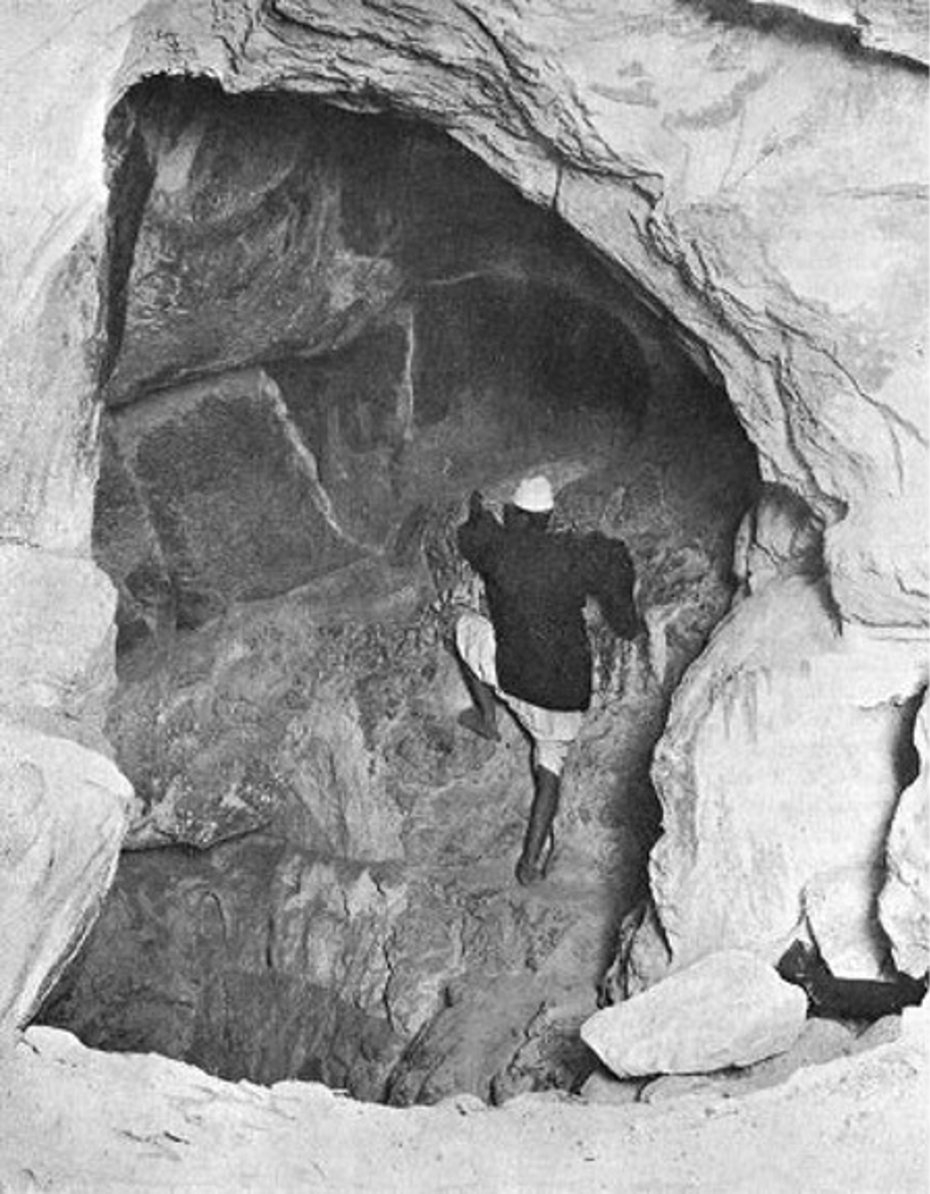
Photograph of the cavity of Al-Ma'mun : "Great Pyramid Passages, Volume 1, by John and Morton Edgar, 1910" : Plate LXIV, page 166 : https://archive.org/details/GreatPyramidPassagesVol11910Edition/page/n174/mode/1up
34.33 The funnel cavity inside the Al-Ma'mun cavity
The granite block fully appearing on the above picture, is Taweret: the former sealing block of the inclined well, which has been released by the Bes wedging block and stopped by the second granite block partially appearing on the photograph; that block is the shock absorber "the Savior" block.
Poster un commentaire
